New Items
Sigma 120-300 f/2.8 Part II: Comparative Anatomy
We know the optical formula for the new version of this lens is the same as the old version. We know it has the ability to be reprogrammed and adjusted with the new Sigma dock and Optimization Pro Software. We know there have been some changes to the mechanics and structure of the lens, but we don’t know exactly what they are.
We have enquiring minds. We believe we have a right to know exactly what’s different when someone just says ‘it’s better, and worth an extra $1,000’. We also have Canon mount new and old versions of the old and new lens sitting on the shelf, at least for the moment. You know what happens next, right?
Plus, as I mentioned in Part I of this series, I really want to know if this lens, which has historically been less than reliable, has made changes that might improve reliability. Most repairs seem to involve the focus assembly, OS unit, or focusing motor. So I was eager to see if this area had been redesigned, changed, or beefed up somehow.
So let’s have a look inside. Yes, I know you don’t ever plan to disassemble your lens. You don’t plan to rebuild your next car’s engine, either, but I bet you look under the hood before you buy it.
The outside is promising – there are clearly different external barrel assemblies and the new lens is a bit thicker at the back end.
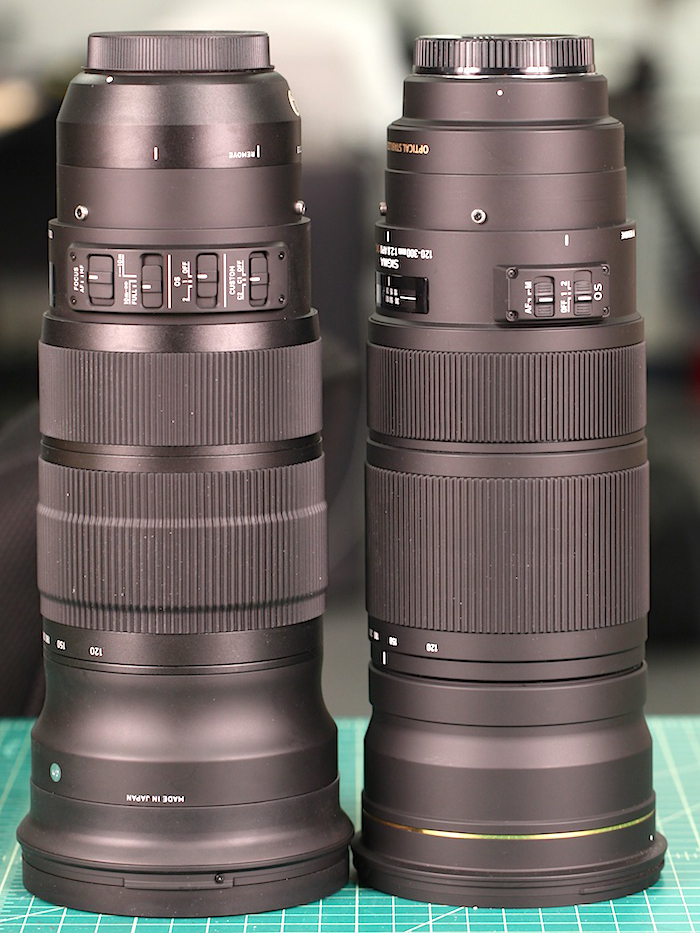
When we take off the lens mount, differences become quickly apparent. The old mount has the usual 4 screws with shims underneath (probably to fine tune infinity focus).
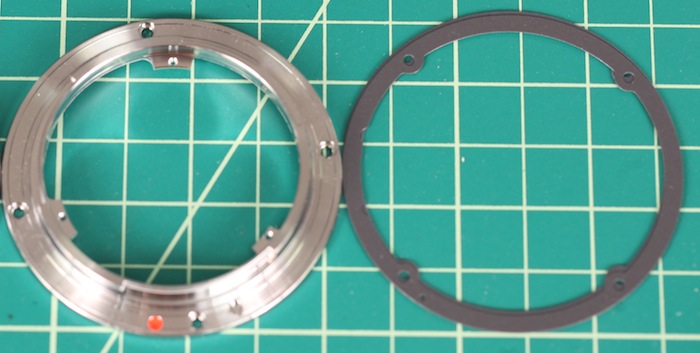
- Original mount
The new mount is quite different. First of all it mounts with 6 screws rather than four and it mounts to a polymer plate. The shims are located between the plate and the rear barrel. One thing to note, though, the 6 screws aren’t really holding the mount to the lens. Two of them simply hold the plate to the rear mount, only 4 pass all the way through to the lens body (as the shims clearly show). That’s not a negative, though. I don’t know of any lens that uses more than 4 screws to hold the mount on. I just want to point it out because I’m certain someone is going to be going on about ‘the sturdier 6-screw mount’.
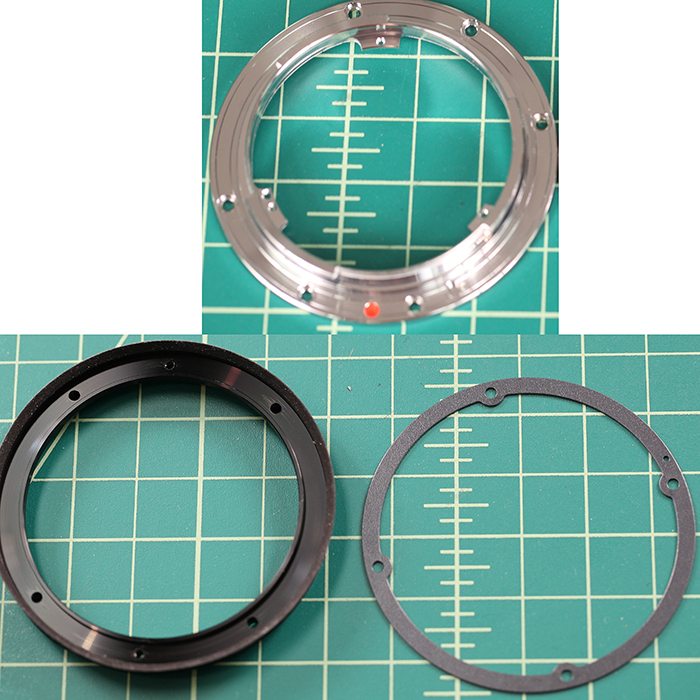
- New version mount
With the mounts off, we can see another difference with the new lens: the weather sealing is clearly more robust. The new lens has a foamed rubber seal (red pointer) between the mount and the barrel instead of a thin rubber ring.

Looking into the barrel we can compare the circuit boards. The new lens’ board is a complete circle, while the old lens has a gap (red pointer). This isn’t surprising since we know there must be more circuitry for the programmable switches and the dock. There are a couple of different / extra chips on the new PCB, but most of the circuit traces and all of the connections are identical.
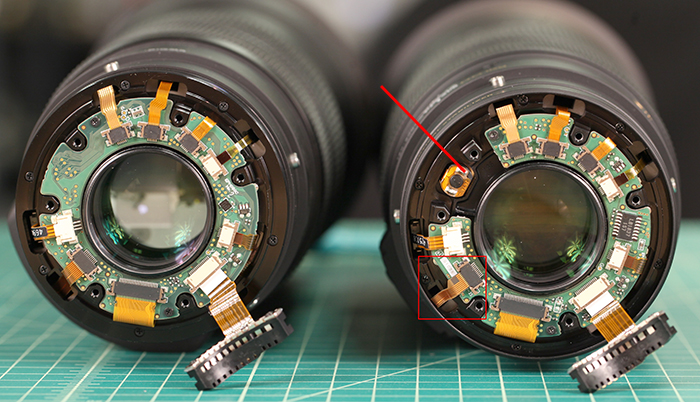
- The newer version has a complete circular PCB, while the older one is C shaped.
Looking close up (in the red square above), we can see an interesting difference in the flex cable coming from the switch panel. The connector is the same on both circuit boards. On the new lens all 10 connections from the switch are used. Not surprisingly (since it doesn’t have custom switches) the old lens only uses 6 wires. What is a bit surprising is it still used a 10 wire connector with 4 dead-end wires in the flex (red arrow). This makes me think that Sigma, a couple of years ago, knew they’d need those extra wires one day. Otherwise why not simply use a 6-wire flex and connector in the first place?
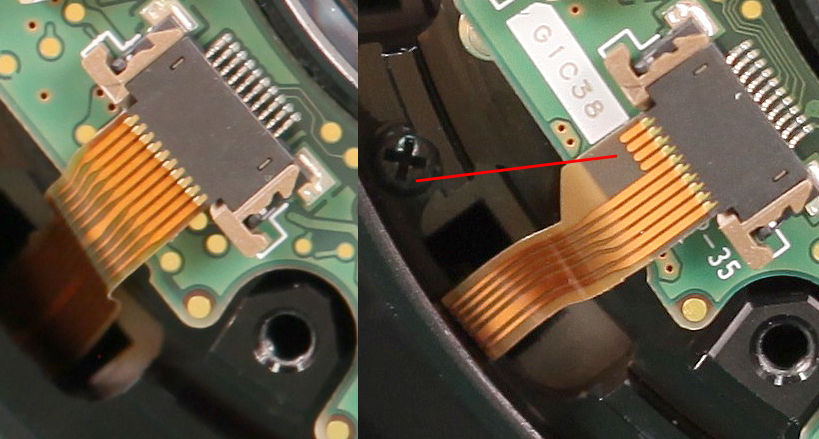
Other than that interesting tidbit there were no differences at this level,so we removed the rear barrel. First the good part: the new rear barrel has a second area of thick, water resistant rubber lip where it seals to the main barrel (red pointer). The original just has a thin rubber washer.
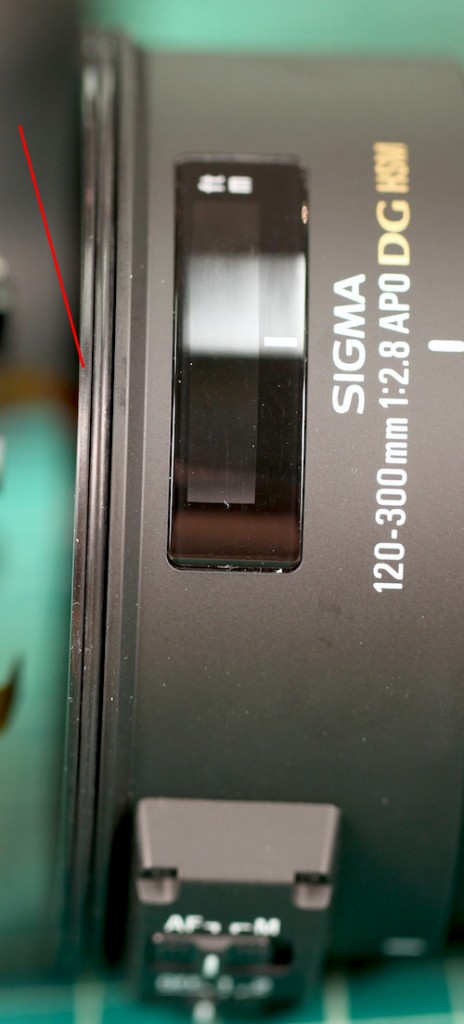
When we took the rear barrels off, the main mechanical / electrical package of the lens is exposed. This group contains the OS unit, the aperture unit, and the focusing unit. Looking at them side by side it doesn’t appear that there are significant differences.
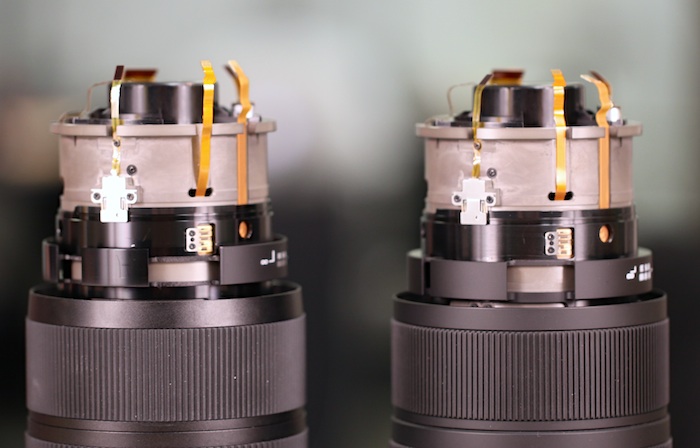
- The electronic unit on the old (right) and new lenses seem identical.
But changes could be subtle so we removed the units to examine them more closely. These units are interesting: the focusing/aperture/OS unit in this lens is quite self-contained and by itself is about as large as a Canon 24-105mm lens.
You might appreciate seeing this if you’ve ever sent one of these lenses in for a failure in either the AF motor or OS unit and the service center notified you they had replaced both. I would expect this unit is a single repair part (we don’t know because Sigma doesn’t release parts lists). It would probably be more cost-effective to replace the whole unit than to take it apart and replace just the one bad part, which would be very time consuming.
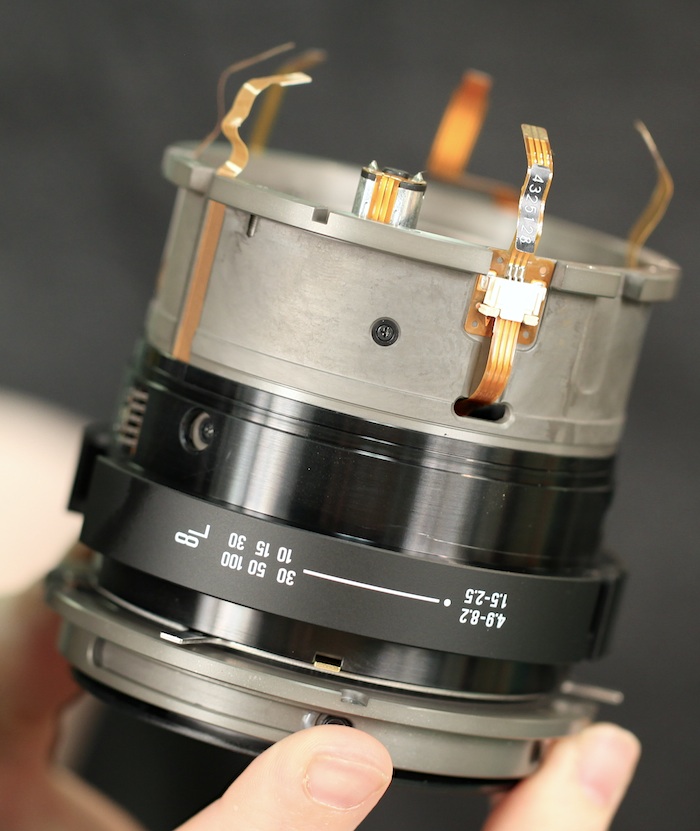
Those metal prongs you see sticking out just above the first element in this group are the manual focusing keys that rotate the large focusing element. (The front lens you see isn’t the one that focuses, it’s the group just behind it.) This is a big, heavy focusing group and moving it you can understand why AF is not quite as fast in the big Sigma zoom as in some other lenses; that AF motor is moving a big load.
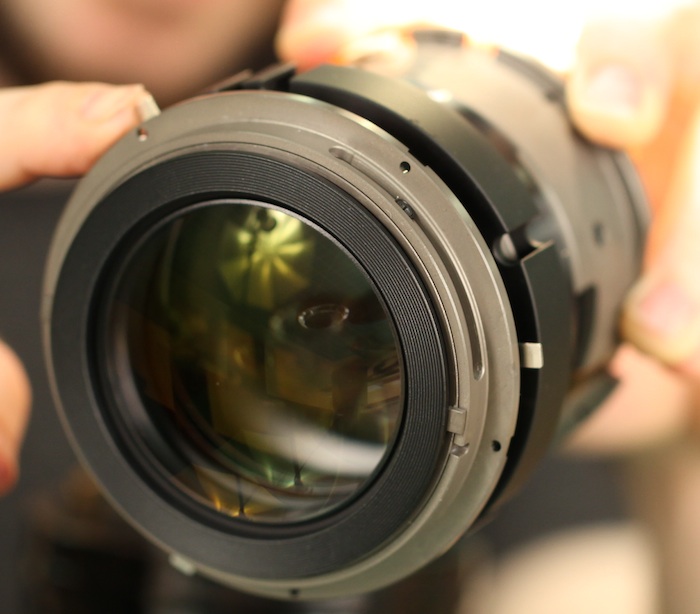
Back to my original point, though, as best we can tell the focusing/aperture/OS unit is identical between the two lenses. In fact, we could put the unit from the new lens in the old one, and vice versa, and they fit perfectly. (We didn’t hook them up because I don’t know if the electronic connections would be identical.)
Hoping we’d see some more subtle changes in electronics, we took things apart a bit more. Taking the OS units out, though, showed them to be identical, right down to the part numbers.
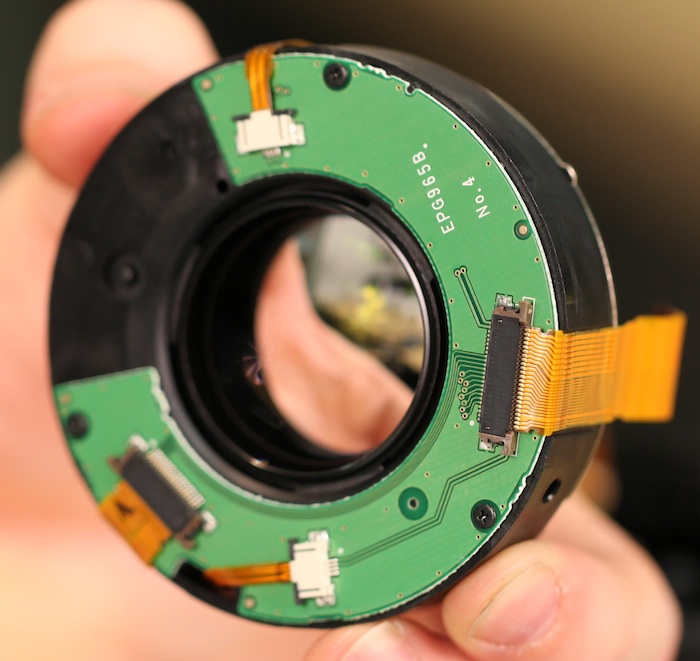
- OS unit from the original 120-300mm OS
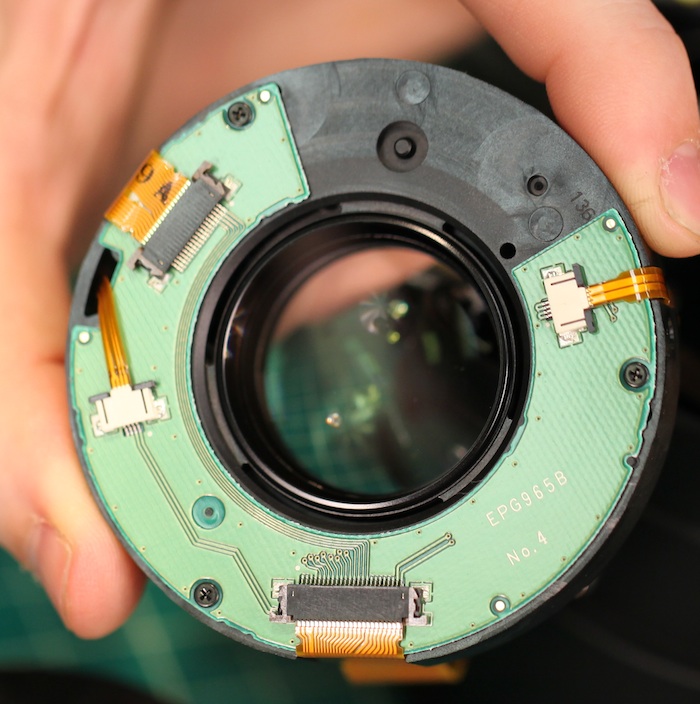
- and from the new version
We didn’t completely disassemble the AF motor and aperture systems, but with the OS unit out of the way (it sits in the back of this unit) we could see inside quite clearly and could not find any difference between the new and old versions.
This doesn’t mean the new lens won’t be more reliable. There could be differences in quality control and assembly that we could not see. A slightly thicker piece here or there could be critically important but not something we would have noticed. Just because I couldn’t find any differences doesn’t mean there aren’t differences.
But to me, this means I’ll believe the new lens is more reliable when I see it is more reliable. Of course, I’ll be keeping statistics on failure rates of the new versus the old versions, but it will take 6 to 12 months before we have even a hint of any reliability improvements. At this point, there’s nothing that makes me confident things will be different.
While we’re here, you probably want to see the front of the lens; after all that’s the biggest part of the lens. It’s also the simplest part, containing just a few large elements and the zoom helicoid. I still find it impressive how large those elements are, even in the middle of the lens. There are no electronics in the front section other than a zoom position sensor, and nothing up there that has ever failed in our experience.
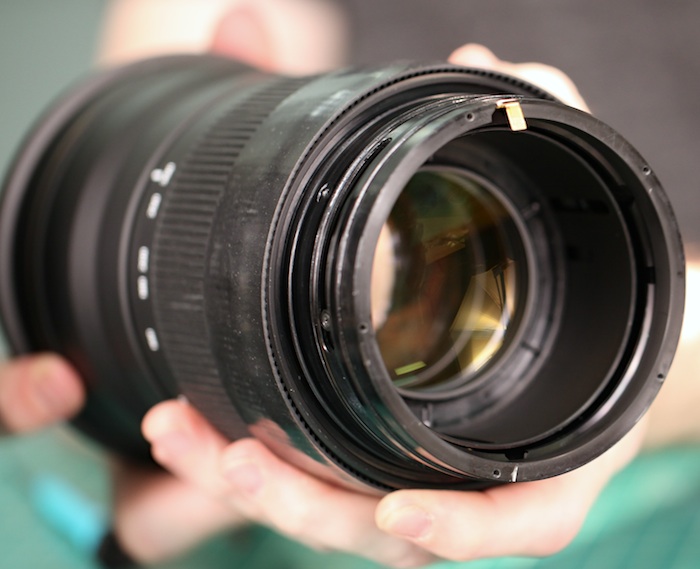
- Front barrel showing zoom group and inner zoom barrel.
Summary:
The 120-300 f/2.8 OS is a lens with unique capabilities, and as you can see some unique design features. The new version gives us some clear improvements that will make the lens more usable for a lot of people, and hopefully will end problems some users have had with back and front focusing.
The optics, and as best I can tell, electromechanical construction is unchanged between the original and the new version. Until we get some long-term reliability data, I can see no reason to think this lens won’t continue to be, shall we say, a bit delicate.
That’s not a deal breaker. To get a high-quality f/2.8 telezoom at this price (even the new version has to be considered reasonably priced compared to other supertelephoto lenses) there are going to be some compromises. Plus the improvements in Sigma Service and Repair make a breakdown less life-shattering than it once was.
Unless I knew I needed the programmability features, though, I don’t see a huge reason to pay for the new version. I’d probably take my chances with a copy of the old version.
Roger Cicala and Aaron Closz
Lensrentals.com
June, 2013
All images copyright Roger Cicala and Lensrentals.com, 2013. You may reproduce as long as you credit the photo and link back to this article.
Author: Roger Cicala
I’m Roger and I am the founder of Lensrentals.com. Hailed as one of the optic nerds here, I enjoy shooting collimated light through 30X microscope objectives in my spare time. When I do take real pictures I like using something different: a Medium format, or Pentax K1, or a Sony RX1R.
-
Laser-x Alain
-
Nicolas Strauel
-
Jos MARTENS
-
Mouette et Jambon
-
Jos MARTENS
-
Mouette et Jambon
-
Jos MARTENS
-
Jura Štok
-
Paul Raymaker
-
Liz
-
Chuck Lantz
-
Mike Dougherty
-
Kerry Pierce
-
Kerry Pierce
-
Jeremy
-
bossa
-
Fabio Bernardino
-
Keeley
-
bossa
-
Samuel H
-
Fake Name
-
TPLAV
